Field Notes on Patents in an Expanded Architectural Field
Claim: We can trace the architectural character of the sociotechnical associations between the human body and its environment in non-building figures like mobile vehicles.
N.B. A complementary part of this claim, not discussed here, is that we can examine how the mundane relational politics of enclosure and mobility figures affective bodies, where militarisation can be “traced and interrogated in more accountable ways” (Isla Forsyth in Merriman et al. 2017:50; also Rech et al. 2015).
*Dr Fadi Shayya is a Lecturer in Architecture & Urbanism at the University of Salford, UK
\\\\\\\\\\\\\\\\\\\\\\\\\\\\\\\\\\\\\\\\\\\\\\\\\\\\\\\\\\\\\\\\\\\\\\\\\\\\\\\\\\\\\\\\\\\\\\\\\\\\\\\\\\\\\\\\\\\\\\\\\\\\\\\\\\\\\\\\\\
In these field notes from my doctoral research at the University of Manchester (Shayya, 2021), I raise questions about patents as cosmogarms, i.e., “external depictions of the elements of the cosmos and the connections among them” (Tresch, 2007, p. 92), associated with planetary design as a practice of scalable technics. I also catalogue observations about architectural associations between militarised bodies, armoured vehicles, and landscapes. I present my analysis in a hybrid format of field notes and a visual essay, which can be read as a set of non-sequential, quasi-ethnographic observations. Readers can rearrange them to generate nuances or trace their actor-networks across a transdisciplinary thought experiment. These observations form the basis of an upcoming research publication on the architectural translations of survivability.
Questions: architecture, mobility, horizontality
\\\\\\\\\\\\\\\\\\\\\\\\\\\\\\\\\\\\\\\\\\\\\\\\\\\\\\\\\\\\\\\\\
I collected these notes and empirical media during my doctoral research fieldwork (2017-2019). They allowed me to assemble an alternative field to study mobile architectures – as relevant to architects, designers, and engineers – or the architectures of mobility – as relevant to geographers and sociologists. Inspired by STS and Bruno Latour’s call to house the nonhuman masses in a new social theory (1992) and Albena Yaneva’s theorisation of associations that bind us architecturally (2009, 2010, 2017), my proposition expands the scope of architectural research to include the expansive domain of inhabitation where humans and mobile machines inhabit each other – as much as humans inhabit stationary buildings in the traditional architectural perspective.
- Why is it timely and relevant to expand theorising the architectural – not architecture – in an increasingly mobile world?
- How can the architectural become a conceptual framework to study the privileging of some bodies and not others in networks of atmospheric planetary associations?
- How can the architectural, as diagrams of cosmic relations, be mapped to differentiate body-environment associations?
- Where should we conduct fieldwork and trace the architectural as body-environment associations beyond the figure of the stationary building?
Imagine an extreme car accident. Nobody trains for car accidents. We “delegate” (Akrich & Latour, 1992; Latour, 1992) safety to measures like driver training, crash tests, traffic regulations, and to devices like seatbelts, airbags, and crumple zones; but the human body is never trained to be injured in a car accident, except in some instances of extreme sports, space travel, and military training.
What does this mean? One recognisable answer suggests that mediators work on behalf of the human body. Engineers and scientists delegate kinetic impact testing to crash test dummies and vehicle frames, measuring seatbelt restraint and chassis deformation, among others. The dummies abstract the collision impacts into a data set, rendering the human body a spectre of speculative breakdowns – until a road crash happens. The favourable outcomes of the impact testing and safety simulation in the lab get “scripted” (Akrich, 1992) as safety design standards and protocols in automotive design.
Part social scientist, part architect, I ponder these questions, thinking about how people train for emergencies like escaping fires and sheltering from earthquakes, bombing, or nuclear fallout. The assumption is that most people do not train properly or at all, or it does not matter whether they do or not in the case of the criminal annihilation of people and landscape in Gaza.
Safety training, civil defence, or disaster preparedness is bound to how a body – in absolute, not a specific person’s body – gets trained. The training is conceived and practised as an anticipatory disciplining measure whose ultimate objective is to increase the body’s survivability by navigating the immediate and looming danger.
- Fire: head to the nearest fire escape.
- Earthquake: shelter in a clear, open area.
- Car accident: wear a seatbelt.
- Air raid: run to a bomb shelter.
- Nuclear threat: seek refuge in a fallout shelter.
Then, there is the discursive training that never actualises except during an emergency.
- Wear oxygen mask in case aeroplane cabin pressurisation fails.
- Break glass in case of smoke on bus/train.
- Do not close open windows on the bus (during the COVID-19 pandemic)
However, extreme technological organisations, like the military, astronauts, firefighters, and mechanical sports, have different practices for pre-figuring the body-risk training relationship. The human body gets “enrolled” (Akrich, 1992) in specialist training programmes, as part of the human-machine hybrid performance.
Rollover: extreme body-environment associations
\\\\\\\\\\\\\\\\\\\\\\\\\\\\\\\\\\\\\\\\\\\\\\\\\\\\\\\\\\\\\\\\\
In STS, enrolling the body is analysed as a practice of coding body parts (Latour, 1996a, 2004; Mol, 2002), but not through associations of an architectural character between the enrolled body and its enrolment environment. Let us consider the case of a violent mobility event, a military vehicle rollover. My field notes trace this event to war operations and the U.S. military’s protracted occupations of Iraq and Afghanistan.
Rollover is an extreme spatio-morphological figure of body-environment association. It destabilises the horizontal habitable space once it passes the maximum side slope angle (varies for different vehicles, but usually less than 40%). A vehicle flips on its side (90 degrees), on its top (180 degrees), or rolls (more than 180 degrees). Usually, this is a function of a vehicle destabilising on a flat surface under its speed and weight, destabilising on uneven or unstable ground, or upon a blast’s thrust. Rollover impacts the human body in three ways inside the enclosure: the body gets displaced, experiences extreme vibrations, and gets trapped.
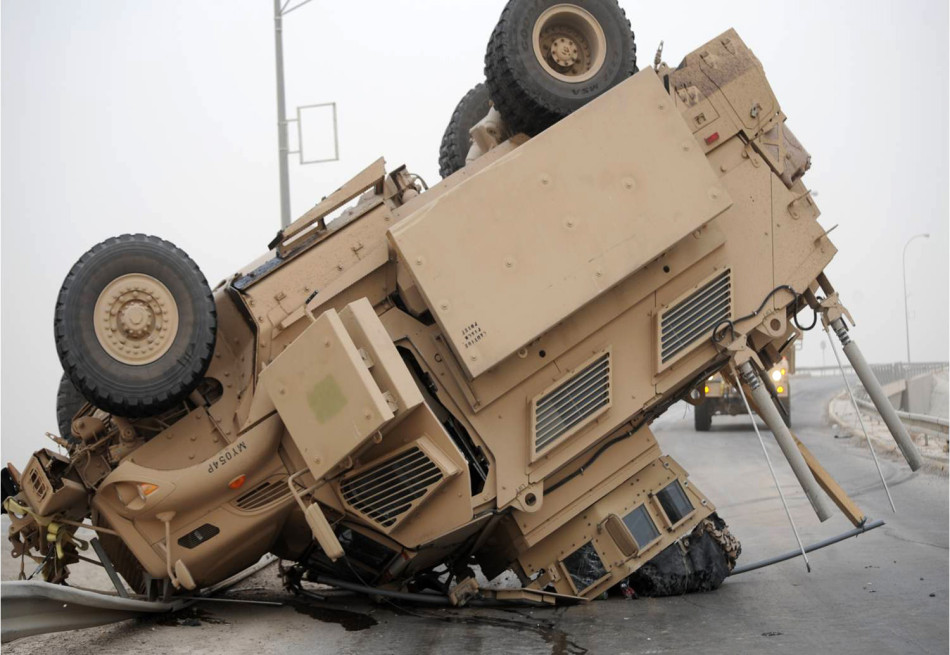
A photo showing a typical vehicle rollover on a flat, paved surface; notice how the rollover destabilises the intended upright horizontality of the vehicle’s interior. Original photo in Baghdad captioned “A Mine-Resistant Ambush-Protected vehicle rests on its turret and hood after a rollover…" (Photo credit: 1st Cav Div Safety Office; via Burke, 2009).

A graph showing a technical representation of rollover on a flat, paved road; notice how the curve represents the critical transformation threshold for the spatio-morphological figure of inhabiting mobility, as a function of the vehicle’s speed and geometry. The graph is from the 1979 Test Activity Report of the U.S. Army Test and Evaluation Command (TECOM) when the military first studied rollover (Varigas Research, Inc., 1979, p. 76).
Lived experience and evolutionary biology tell us humans must stand and walk upright, not hang upside down. Thus, horizontality emerges as an ontological association between body and terrain for being and becoming human. However, horizontality is not a given property in nature; instead, it is one that humans must generate, mass produce, and maintain as an architectural association for making space for inhabiting a medium. You can see and experience this all around us in the single or multiple flat surfaces of multi-storey buildings, car interiors, aircraft cabins, truck beds, double-decker buses, cruise ship decks, roads, and stacked interchanges.
Mobility renders horizontality complexly dynamic. Humans delegate mobile architectures the task of dynamically maintaining and continuously negotiating that horizontality. In buildings, soil mechanics and engineered foundations actualise a stabilisation, which also recruits dampers, pendulums, and mesh structures for earthquake-proof construction. For land vehicles, suspension is the invention that accounts for these concerns until a vehicle rolls over. So, what does it mean for a breakdown to have a morphology? And how can we trace it?

Cosmogram for Manoeuvrable Rooms: Architectural Associations from Station Wagons to SUVs; the sociotechnical development of the sport utility vehicle type (SUV) through architectural associations between rough terrain, reduced bouncing, and ample family space (Student group: Ahmed Ali, Yutong Liu, Daryl Quayle, and Zilang Zhao; Mobile Architectures Research Methods Workshop; 2022 Master of Architecture, Manchester School of Architecture, UK).
Method: tracing the disappearing horizontal in breakdowns
\\\\\\\\\\\\\\\\\\\\\\\\\\\\\\\\\\\\\\\\\\\\\\\\\\\\\\\\\\\\\\\\\
Through an STS- and ANT-inspired methodology, I trace a breakdown of MRAP-type vehicles employed for increased concerns of U.S. military survivability. This breakdown is not only an event in the field. Rather, it is distributed across references where the world is packed into words (Latour, 1999, p. 24). It is distributed in the form of cosmogrammatics, i.e., elements that represent the rollover world as found in utility patents, technical reports, news stories, and photo-video documentation.
“Soft soil poses a risk to MRAP vehicles. It is likely that the four-wheeled MRAP vehicle poses a greater risk of sinking or bogging down in soft soil. Avoid moving too close to the edges of roads that may collapse and cause the vehicle to tip over …”
Excerpt on “Capabilities and Limitations” from the MRAP Handbook (Center for Army Lessons Learned, 2008, pp. 25–26).
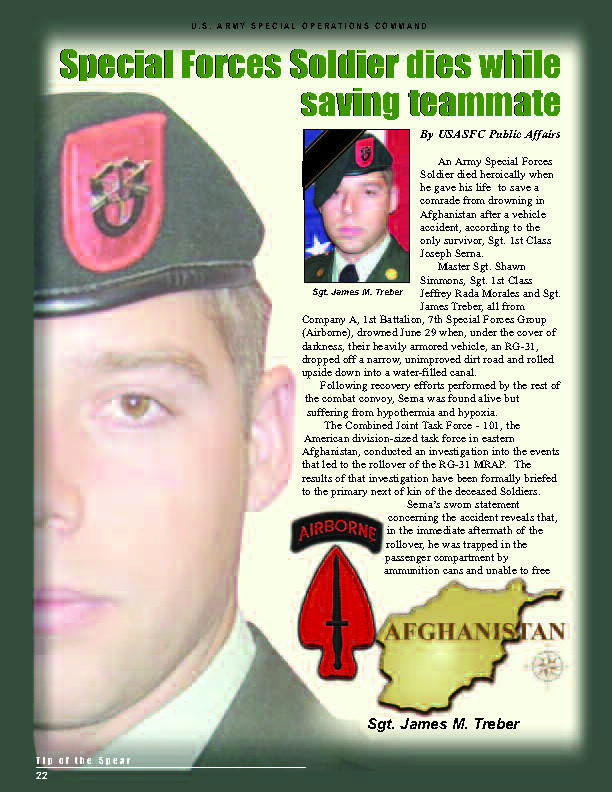
Pages from Tip of the Spear magazine narrating an incident of MRAP rollover and U.S. Army servicemen death in Afghanistan (USASFC Public Affairs, 2008, pp. 22–23).
“Master Sgt. Shawn Simmons, Sgt. 1st Class Jeffrey Rada Morales and Sgt. James Treber, all from Company A, 1st Battalion, 7th Special Forces Group (Airborne), drowned June 29 when, under the cover of darkness, their heavily armored vehicle, an RG-31, dropped off a narrow, unimproved dirt road and rolled upside down into a water-filled canal … Following recovery efforts performed by the rest of the combat convoy, Serna was found alive but suffering from hypothermia and hypoxia.”
Excerpt from Tip of the Spear magazine (USASFC Public Affairs, 2008, p. 22).
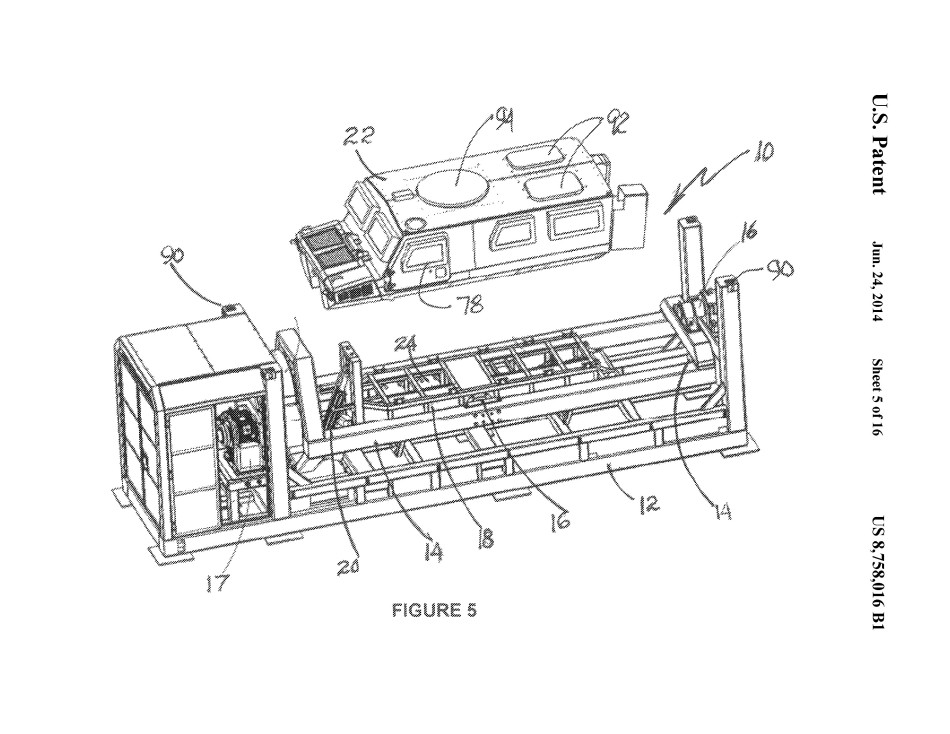
Patent art from U.S. Patent no. 8,758,016 B1 titled Vehicle Driver and Combat Situation Simulator (Henriksson, 2014). The drawing shows a schema for a simulator device to imitate the rollover that killed Master Sgt. Shawn Simmons, Sgt. 1st Class Jeffrey Rada Morales and Sgt. James Treber. The imitation aims to train soldiers on expecting such breakdown in anticipation of reducing injuries and fatalities.
Two notes here:
First. The patent emerges as a critical empirical site to trace associations between the enrolled body and its enrolment environment. It is an unusual reference for architects and urbanists. Although it is primarily a techno-legal apparatus to territorialise industrial copyright (see Bowker, 1992), a patent enacts innovation as public and referential sociotechnical associations – including ones with an architectural character – susceptible to development, forgetfulness, or re-emergence (see Shayya, 2021). The patent constitutes a modern cosmogram that embodies and enacts a worldview through a technical mode of existence (borrowing from Simondon, 1958/2017), assembling cosmic things (after Tresch, 2007) and depicting the localisation (after Latour, 2005) of geopolitics through clear associations between the technical object and its environment.
Second. Analysing a vehicle enriches an alternative field for studying the architectural as a type of associations. It extends the architectural as a relationship between humans and the human-shaped landscape beyond buildings. Stories of body-environment associations could be traced in various media including text, patent art, photos, and videos, and abstractions of the human-made landscape could be traced in rotating machines, training procedures, rollover simulations, and psycho-bodily traumas.
Accordingly, these field notes exploring mobility and horizontality breakdowns helps me expand the concept of the architectural in my doctoral thesis, one that reads armoured military vehicles like the MRAP as a “… highly protected and enclosed atmospheric capsule that privileges the survivability of specific bodies and not others” (Shayya, 2021). The wider scope of the thesis observes how such capsule translates terrain through technics of survivability and enrols active bodies in protective envelopes across networks of simulation and training, which we can read through an “architectural” (after Yaneva, 2010) lens across the ground as “technical lands” (Galison, 2022). The thesis argues that the cosmogrammatics of patents open the field of architectural research to investigate how military sociotechnical imaginaries of survivable mobilities fold Afghanistan’s rugged landscape into the performance of vehicular spatialities and militarised bodies.
Inhabiting the non-horizontal: A few empirical leads
\\\\\\\\\\\\\\\\\\\\\\\\\\\\\\\\\\\\\\\\\\\\\\\\\\\\\\\\\\\\\\\\\
So, how do humans inhabit the non-horizontal, especially in an extreme situation like a rollover? In the following institutionally-documented evidence from the field, we can see how the US Army folds the impacts of an MRAP’s rollover into the soldiers’ bodies. The landscape (of Iraq and Afghanistan), risk (of bodily trauma), and breakdown (or rollover) are abstracted and simulated in a universal training exercise called MRAP Egress Training using a device called the MET –MRAP Egress Trainer.
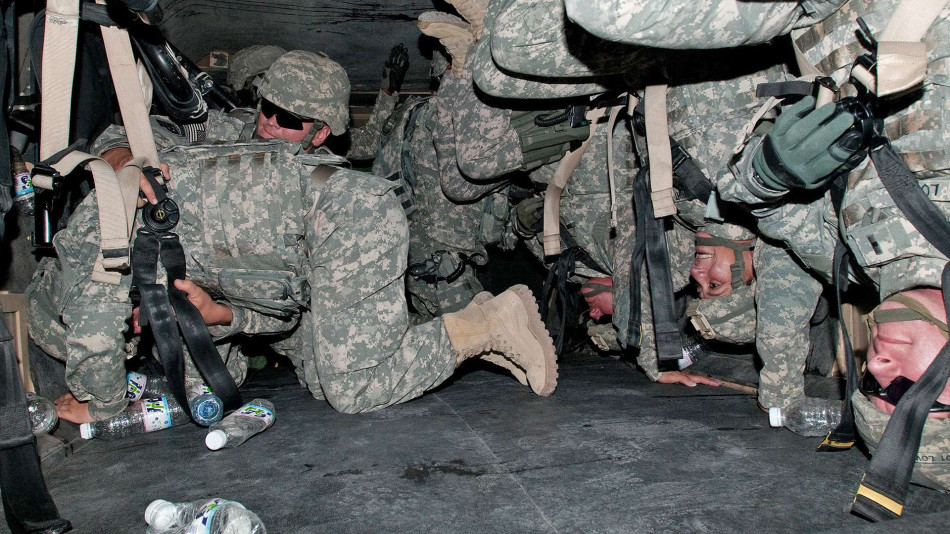
A photo showing airmen flipped upside-down during an MRAP Egress Training rollover simulation at Joint Base McGuire-Dix-Lakehurst, New Jersey, U.S. It is a simulation of a rollover to unpack the mundane situation of inhabiting unusual positions beyond the upright world. The training familiarises soldiers with unusual, capsized positions and possible psycho-physiological traumas. By tumbling inside the MET, the soldiers experience nausea (due to rotation) and disorientation (everything is flipped). They learn first-hand how to react to shock, recognise their bodily boundaries, communicate with each other, and unbuckle their seatbelts to exit the enclosing capsule. Unlike astronauts who train for zero gravity, soldiers are governed by the Earth’s gravitational field. Their upside-down rollover training is a temporality bound by quickly re-transitioning to an upright world, although this is not a guaranteed outcome in the field that leads to death – see the Tip of Spear story in the previous section (Photo credit: U.S. Army; via Rogoway, 2017).

A spatial mapping exercise led by a trainer (standing to the right) to unpack the mundane situation of sitting in a moving vehicle. The soldiers simulate how they inhabit their vehicle’s armoured capsule to anticipate the assemblage they will be part of in the field. Their bodies occupy a seating arrangement, thus generating a cognitive map for spatialising the capsule: the driver holds a mock steering wheel, the crew is seated, and the gunner is standing. The capsule is absent as an object but imagined as a bounding space (Illustration by author; original photo below).
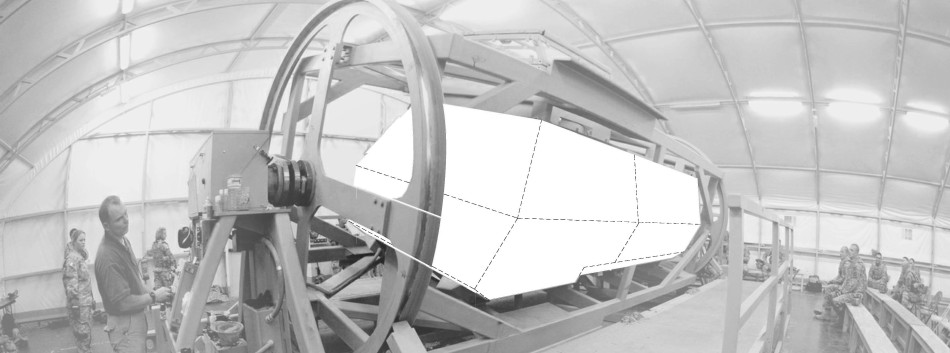
The MRAP cab, or architectural capsule, displaced from the field into the lab to simulate the rollover breakdown via a rotating drum and discipline the soldiers’ bodies. The result is the MRAP Egress Trainer (MET), which the author traced in U.S. Patent no. 8,758,016 B1 (Illustration by author; original photo above).
Cosmogrammatics of a planetary design
\\\\\\\\\\\\\\\\\\\\\\\\\\\\\\\\\\\\\\\\\\\\\\\\\\\\\\\\\\\\\\\\\
“At what scale, with what materials, and by way of which methods the planetary becomes incorporated into an expanded notion of design?” (Parikka, 2023)
Reading U.S. Patent no. 8,758,016 B1 Vehicle Driver and Combat Situation Simulator comogrammatically shows a technical register of “polyscalar” (Parikka, 2023) architectural practices. A first scale: technical thought grapples with the possibilities and thresholds of inhabiting the non-horizontal, upon the rollover breakdown. It negotiates a survivable rollover instead of preventing it. A second scale: science and engineering abstract the landscape to simulate the breakdown. They reassemble schemas from across inventions to generate the MET rollover training device. A third scale: operational logics fold the consequences of rollover and inhabiting the horizontal into the soldiers’ bodies through training and procedures in the lab. Thus, the rollover event creates a sociotechnical narrative that re-figures the body-environment associations across imaginaries, geographies, and materialities.
In this sense, a patent is not strictly an “immutable mobile” (Austrin & Farnsworth, 2005; Latour, 1988), an inscription that moves without transformation. Rather, my field notes briefly illustrate how a patent operates as an archive of cosmic relations – a cosmogram – that document sociotechnical flows in diagrams of body-environment associations.
This is not the iconic cosmogram we know of – a mandala, the Holy Trinity, or the Forbidden City. It is a translation of the science-engineering-military network into human-machine-space associations representing the military’s world: a rollover-resilient human body that can survive non-horizontal worlds inside a rotating capsule, i.e., the military’s sociotechnical mode of existence in the occupied soft-soil landscape of Afghanistan.
\\\\\\\\\\\\\\\\\\\\\\\\\\\\\\\\\\\\\\\\\\\\\\\\\\\\\\\\\\\\\\\\\\\\\\\\\\\\\\\\\\\\\\\\\\\\\\\\\\\\\\\\\\\\\\\\\\\\\\\\\\\\\\\\\\\\\\\\\\
Bibliography
- Akrich, M. (1992). The De-Scription of Technical Objects. In W. E. Bijker & J. Law (Eds.), Shaping Technology / Building Society: Studies in Sociotechnical Change. MIT Press.
- Akrich, M., & Latour, B. (1992). A Summary of a Convenient Vocabulary for the Semiotics of Human and Nonhuman Assemblies. In W. E. Bijker & J. Law (Eds.), Shaping Technology / Building Society: Studies in Sociotechnical Change. MIT Press.
- Austrin, T., & Farnsworth, J. (2005). Hybrid Genres: Fieldwork, Detection and the Method of Bruno Latour. Qualitative Research, 5(2), 147–165. https://doi.org/10.1177/1468794105048651
- Bowker, G. (1992). What’s in a Patent? In W. E. Bijker & J. Law (Eds.), Shaping Technology/Building Society: Studies in Sociotechnical Change (pp. 53–74). MIT Press.
- Foucault, M. (1995). Discipline and Punish: The Birth of the Prison (A. Sheridan, Trans.; 2nd edition). Vintage Books.
- Galison, P. (2022). Foreword: What Are Technical Lands? In J. S. Nesbit & C. Waldheim (Eds.), Technical Lands: A Critical Primer (pp. 18–27). Jovis.
- Latour, B. (1992). Where Are the Missing Masses? The Sociology of a Few Mundane Artifacts. In W. E. Bijker & J. Law (Eds.), Shaping Technology / Building Society: Studies in Sociotechnical Change (pp. 225–258). MIT Press.
- Latour, B. (1988). Visualisation and Cognition: Drawing Things Together. In H. Kuklick (Ed.), Knowledge and Society Studies in the Sociology of Culture Past and Present (Vol. 6, pp. 1–40). JAI Press.
- Latour, B. (1992). Where Are the Missing Masses? The Sociology of a Few Mundane Artifacts. In W. E. Bijker & J. Law (Eds.), Shaping Technology / Building Society: Studies in Sociotechnical Change (pp. 225–258). MIT Press.
- Latour, B. (1996a). On Interobjectivity. Mind, Culture, and Activity, 3(4), 228–245. https://doi.org/10.1207/s15327884mca0304_2
- Latour, B. (1996b). Trains of Thought: The Fifth Dimension of Time and its Fabrication. In A.-N. Perret-Clermont, J.-M. Barrelet, A. Flammer, S. Lambo, D. Mieville, J.-F. Perret, & W. J. Perrig (Eds.), Thinking Time: A Multidisciplinary Perspective on Time (pp. 173–187). Hogrefe and Hupher Publishers. http://www.bruno-latour.fr/node/191.html
- Latour, B. (1999). Circulating Reference: Sampling the Soil in the Amazon Forest. In Pandora’s Hope: Essays on the Reality of Science Studies (pp. 24–79). Harvard University Press. http://www.hup.harvard.edu/catalog.php?isbn=9780674653368
- Latour, B. (2004). How to Talk About the Body? The Normative Dimension of Science Studies. Body & Society, 10(2–3). https://doi.org/10.1177/1357034X04042943
- Latour, B. (2005). Reassembling the Social: An Introduction to Actor-Network-Theory. Oxford University Press.
- Merriman, P., Peters, K., Adey, P., Cresswell, T., Forsyth, I., & Woodward, R. (2017). Interventions on Military Mobilities. Political Geography, 56, 44–52. https://doi.org/10.1016/j.polgeo.2016.11.003
- Mol, A. (2002). The Body Multiple. Duke University Press.
- Parikka, J. (2023). A Natural History of Logistics and Other Studio Briefs: Problem Spaces for Planetary Design. Cultural Politics.
- Rech, M., Bos, D., Jenkings, K. N., Williams, A., & Woodward, R. (2015). Geography, Military Geography, and Critical Military Studies. Critical Military Studies, 1(1), 47–60. https://doi.org/10.1080/23337486.2014.963416
- Shayya, F. (2021). Politics of Survivability: How Military Technology Scripts Urban Relations [PhD Thesis]. University of Manchester.
- Simondon, G. (2017). On the Mode of Existence of Technical Objects (C. Malaspina & J. Rogove, Trans.; 1st edition). Univocal Publishing. (Original work published 1958)
- Till, J. (2007). Three Myths and One Model. Jeremy Till. https://jeremytill.s3.amazonaws.com/uploads/post/attachment/34/2007_Three_Myths_and_One_Model.pdf
- Till, J. (2012). Is Doing Architecture Doing Research? 4IAU 4a Jornadas Internacionales Sobre Investigación En Arquitectura y Urbanismo, Valencia, 2011. https://riunet.upv.es/handle/10251/15032
- Till, J. (2019, April). New Introduction to 3 Myths and One Model. Jeremy Till. http://www.jeremytill.net/read/126/new-introduction-to-3-myths-and-one-model
- Tresch, J. (2007). Technological World‐Pictures: Cosmic Things and Cosmograms. Isis, 98(1), 84–99. https://doi.org/10.1086/512833
- Yaneva, A. (2009). The Making of a Building: A Pragmatist Approach to Architecture. Verlag Peter Lang.
- Yaneva, A. (2010). The “Architectural” as a Type of Connector: A Realist Approach to Architecture. Perspecta, 42, 141–145.
- Yaneva, A. (2017). Five Ways to Make Architecture Political: An Introduction to the Politics of Design Practice. Bloomsbury Academic.
References
- AiirSource Military (Director). (2013, December 11). US Army MRAP (Mine Resistant Ambush Protected) Egress Training. https://www.youtube.com/watch?v=sVnPJI8ycRA
- Burke, R. (2009, November 5). Tactical Vehicle Safety: Slow Down [Military]. United States Army. https://www.army.mil/article/29924/tactical_vehicle_safety_slow_down
- Center for Army Lessons Learned. (2008). MRAP Vehicles: Tactics, Techniques, and Procedures (Handbook No. 08–30; p. 168). U.S. Army Combined Arms Center. https://www.globalsecurity.org/military/library/report/call/call_08-30.pdf
- Henriksson, U. (2014). Vehicle Driver and Combat Situation Simulator (United States Patent and Trademark Office Patent No. 8758016B1). http://patft.uspto.gov/netacgi/nph-Parser?Sect1=PTO1&Sect2=HITOFF&p=1&u=/netahtml/PTO/srchnum.html&r=1&f=G&l=50&d=PALL&s1=8758016.PN.
- Hiler, A. (Director). (2013, May 13). Rollover Training at JB MDL (Video ID: 290516). DVIDS. https://www.dvidshub.net/video/290516/rollover-training-jb-mdl
- Prince, Q. (2019). HEAT Training, Camp Buehring, Kuwait [Image 3 of 5] (Photo ID: 5759653) [Photograph]. DVIDS. https://www.dvidshub.net/image/5759653/heat-training
- Rogoway, T. (2017, October 17). These Armored Vehicle Rollover and Egress Simulators Ready Troops for a Bad Day. The Drive. http://www.thedrive.com/the-war-zone/15234/these-armored-vehicle-rollover-and-egress-simulators-ready-troops-for-a-bad-day
- Simon, P. (Director). (2009, August 9). MRAP Egress Training (Video ID: 66393). DVIDS. https://www.dvidshub.net/video/66393/mrap-egress-training
- U.S. Army. (2005). Survivability of Army Personnel and Materiel (Army Regulation AR 70-75; Research, Development, and Acquisition, p. 24). Department of the Army. https://www.apd.army.mil/epubs/DR_pubs/DR_a/pdf/web/r70_75.pdf
- USASFC Public Affairs. (2008). Special Forces Soldier Dies while Saving Teammate. Tip of the Spear (U.S. Special Operations Command Publication), October, 22–23.
- Varigas Research, Inc. (1979). Methodology Investigation Final Report: Military Vehicle Rollover, Analysis and Instrumentation (Phase I) (Test Activity Report APG-MT-5293; p. 121). U.S. Army Test and Evaluation Command; DTIC Document.
-
An earlier version was presented in a panel[1] titled Cosmogrammatics. Nature(s) in Planetary Designs at the EASST/4S Conference Prague 2020.↩
-
Read more on “architectural research” (Till, 2007, 2012, 2019)↩
-
See the graduate workshop Mobile Architectures↩
-
Extending Foucault’s thesis on how political economy of bodies evolves from corporeal punishment to the economization of the body parts (1995).↩
-
One of the earliest examples is a study by the Highway Safety Research Institute (HSRI) of The University of Michigan for Varigas Research, Inc., monitored by the TECOM. The U.S. Army did not have the research and computing capability for this task then (see graph below).↩
-
What Latour calls “spacing” (1996b)↩
-
See the graduate workshop, Mobile Architectures, I convened for MArch students at the Manchester School of Architecture on the relationality of suspension devices to human inhabitation.↩
-
MRAP stands for Mine-Resistant Ambush Protected vehicles↩
-
I understand technics to mean technical thought in a given technological and energy era, following Gilbert Simondon (1958/2017).↩
-
The notion of the (protective) envelope – rather than the building as a container – is critical to theorize the architectural as a mode of generating an inside-outside association. Here, the envelope is the armoured capsule; in traditional architecture, you come across in the form of creating microclimates.↩



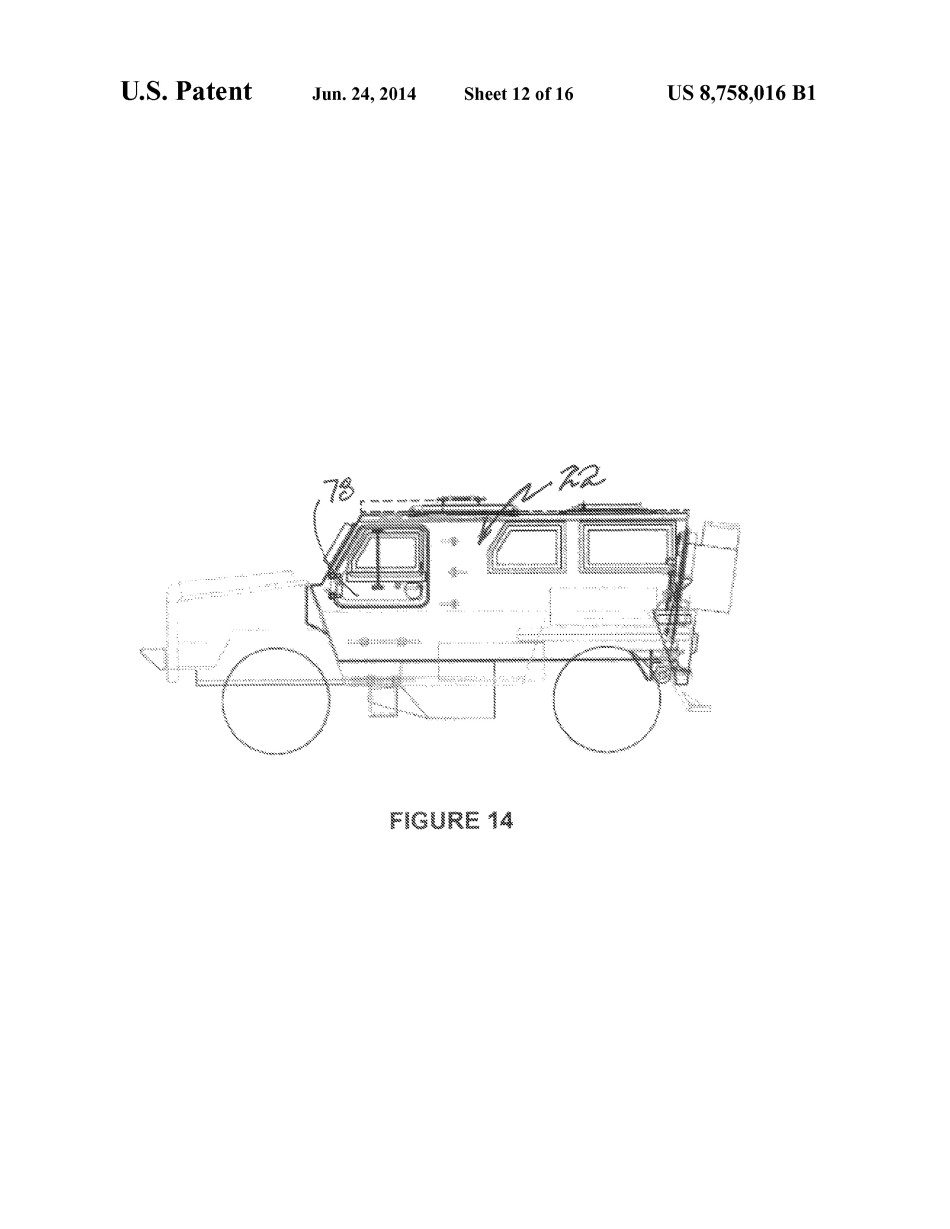

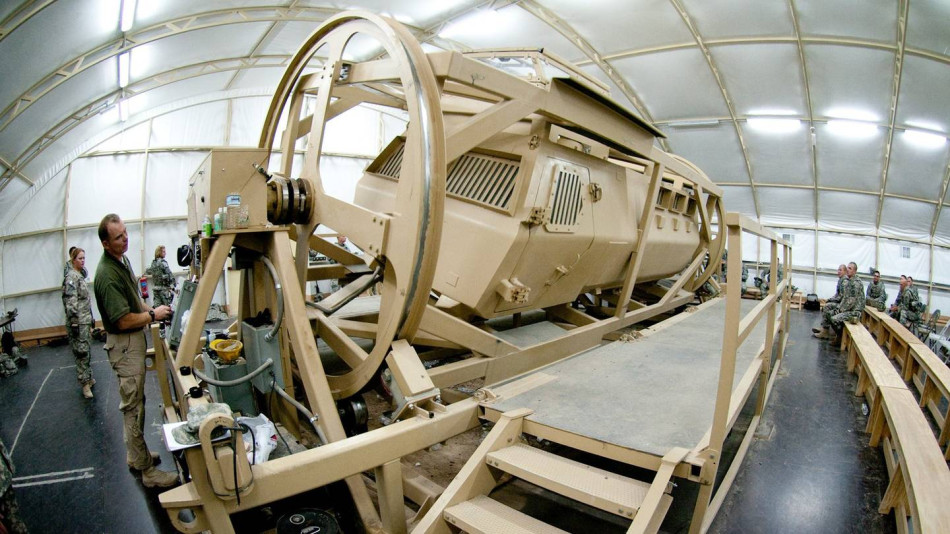

0 comments